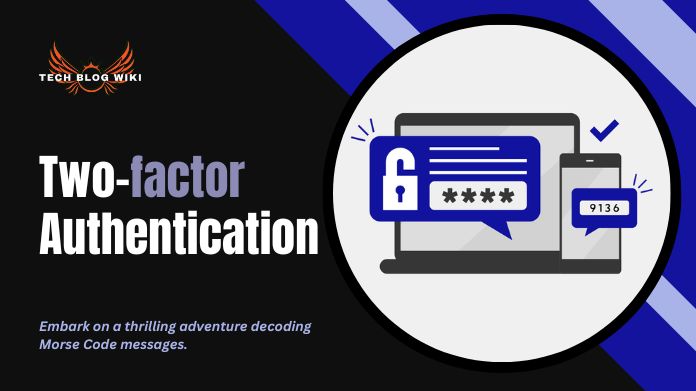Protecting sensitive data, including personal information, has become critical in an era where digital interactions and online transactions predominate.
The persistent evolution and sophistication of cyber threats mean that traditional password protection strategies could no longer be adequate to secure accounts and data. Let me introduce you to two-factor authentication (2FA), a strong security feature that gives digital accounts and services additional safety.
In exploring two-factor authentication, we delve into its fundamental principles, practical applications, and role in enhancing security in the digital age. From its inception as a response to growing cybersecurity concerns to its widespread adoption by leading tech companies and organizations, 2FA has emerged as a critical component of modern security protocols.
Join Techblogwiki as we unravel the mysteries of two-factor authentication, understanding its importance, how it works, and why it’s essential for safeguarding personal and sensitive information in an increasingly interconnected world.
Whether you’re a seasoned cybersecurity enthusiast or a novice navigating the complexities of online security, this journey into two-factor authentication promises to be enlightening and empowering.
Are you ready to embark on this exploration of digital security? Let’s dive in.
What is Two-factor Authentication?

To validate their identity and gain entry to an account or service, users must first submit two distinct authentication factors or two-factor authentication (2FA). By requesting a second form of verification, 2FA provides extra security to existing single-factor authentication techniques, which usually only require passwords or PINs.
To authenticate with 2FA enabled, users must combine two factors from the above categories. For example, after entering a password (something you know), they may receive a one-time code on their smartphone (something you have), which they must enter to complete the authentication process.
By requiring two different authentication factors, 2FA significantly enhances security. It makes it more difficult for unauthorized users to access accounts or sensitive information, even if they have obtained the user’s password.
This extra layer of security helps safeguard against various cyber threats, including phishing attacks, credential theft, and brute-force password attacks, making 2FA an essential security measure in today’s digital landscape.
What Are the Benefits of 2FA?
Here are the benefits of 2FA in simpler terms:
1. Better Security: 2FA adds a layer of security, making it harder for hackers to access your accounts.
2. Protects Against Password Theft: Even if someone steals your password, they still need another way to prove it’s you.
3. Meets Regulations: Many rules say companies must use strong security, and 2FA helps meet these rules.
4. Builds Trust: Using 2FA shows you care about security, making people trust your company more.
5. Stops Account Takeovers: Hackers trying to steal accounts have a more challenging time if 2FA is turned on.
6. Easy to Use: While it adds a step, 2FA options like using your fingerprint or getting a code on your phone are simple and quick.
What Are the Authentication Methods for 2FA?

The authentication methods for 2FA typically fall into three categories:
Something You Know: This involves information that only the user knows, such as a password, PIN, or answers to security questions.
Something You Have: This requires possessing a physical device or token, such as a smartphone, security key, or one-time password generator.
Something You Are: This involves biometric characteristics particular to the user, such as fingerprints, facial recognition, or iris scans.
By combining these authentication techniques, an additional degree of protection is offered during the login procedure. To finish the authentication process, a user might, for instance, input their password—something they already know—and then get a one-time code on their smartphone—something they own.
Alternatively, they might directly authenticate on a device using their fingerprint, which they are. Two-factor authentication (2FA) helps guarantee that only authorized users may access accounts or sensitive data by requiring two distinct forms of authentication.
Examples of Two-factor Authentication
Here are some common examples of two-factor authentication (2FA) methods:
1. SMS or Email Codes: After entering a password, users accept a one-time code via SMS or email, which they must enter to complete the login process.
2. Authenticator Apps: Users generate one-time codes using authenticator apps like Google Authenticator, Microsoft Authenticator, or Authy, which are synchronized with their accounts.
3. Push Notifications: Users receive a push notification on their smartphone prompting them to approve or deny the login attempt. This method is often used with mobile apps.
4. Biometric Authentication: Users verify their identity using biometric characteristics such as fingerprints, facial recognition, or iris scans.
5. Hardware Tokens: Users use physical tokens or security keys, such as YubiKey or RSA SecurID, to generate one-time codes or authenticate directly.
6. Backup Codes: Users receive a set of backup codes during the setup process, which they can use if they don’t have access to their primary authentication method.
These are just a few examples of the many 2FA methods available. Organizations may implement one or more of these methods depending on their security requirements and user preferences.
Final Note
Two-factor authentication (2FA) is crucial for keeping digital accounts safe. It adds an extra layer of security by directing users to provide two verification forms before accessing their accounts.
This helps prevent unauthorized access, password theft, and other cyber threats. The benefits of 2FA include increased security, protection against password theft, and enhanced user trust.
Using 2FA, organizations and individuals can better protect their digital assets and privacy from cyberattacks.






